Scientists have a plan to save Italy's historic mussel farming sea – using plants
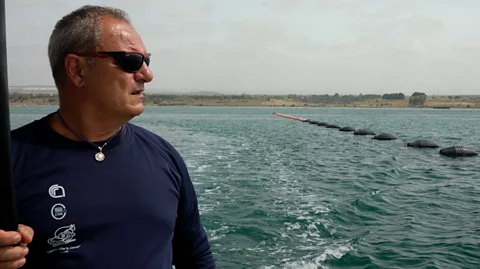 Naomi Mihara
Naomi MiharaDecades of industrialisation have polluted the waters of Italy's Mar Piccolo and brought mussel farming to its knees. Can harnessing the power of plants bring back a traditional way of life?
Adriano Lippo grips the tiller of his small boat, staring out over the dark blue waters of the Mar Piccolo. "I don't think it will happen this year," he says, shaking his head. "Everything is dead." The air carries a scent of salt, heat, and the bittersweet nostalgia of summer's end.
For the past decade, Lippo has made the same journey at the end of every summer, steering his boat between the port and the looming smokestacks of Taranto, southern Italy. His task: to transfer mussels from one inlet to the other across the Mar Piccolo, a semi-enclosed bay located between the city and the open sea. The narrow strait connecting the Mar Piccolo's two inlets has always been a lifeline for mussel farmers – a vital passage to shield their harvests from the contamination that has plagued the first inlet after years of relentless industrial growth.
The first inlet has historically been the best site for collecting larvae, and mussel farmers have passed down this knowledge over the generations, explains Giovanni Fanelli, a researcher working with mussel farmers at the National Research Council in the Istituto di Ricerca Sulle Acque (CNR-IRSA). "The first inlet is closer to the open sea, allowing cooler water to stream in. But for years, it has not been possible to complete mussel growth in that area," says Fanelli, as he bends from his boat to collect a submarine data logger, a device used to record and store environmental data underwater.
When mussels reach a certain size, farmers must transfer them to the second inlet, which lies further from the sources of pollution, to complete their growth. This allows the mussels to purge any toxins they may have absorbed during their early growth phase in the first inlet. But last year, rising temperatures killed the mussels before they could even make the trip. Ninety per cent of mussels were lost in the final weeks of September, devastating current yields and jeopardising future harvests.
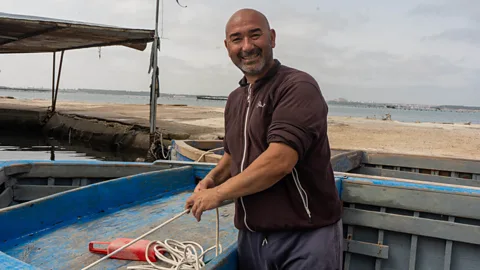 Naomi Mihara
Naomi MiharaOnce the lifeblood of a centuries-old tradition, the Mar Piccolo supported generations of mussel farmers, producing an impressive 60,000 tonnes of mussels annually at the sector's peak in the early 2000s. Since then, mussel farming has been in decline, with pollution and heatwaves exerting ever greater pressure on an already precarious sector.
Now, researchers and mussel farmers are pinning their hopes on a plan to restore the contaminated Mar Piccolo through phytoremediation, a process where plants are used to absorb harmful toxins. While the approach holds promise for both the environment and the livelihoods of mussel farmers, its implementation faces significant hurdles, including logistical challenges, funding constraints and the ongoing impact of heavy industry in the region.
The toll of heavy industry
Known as "the city of the two seas" because of its location between the Mar Grande – the open sea – and the Mar Piccolo, Taranto has long wrestled with the impacts of industrial development. Since 1889, it has hosted Italy's largest naval base and military shipyard, and a major oil refinery and cement plant have been operating since the second half of the 20th Century. More recently, the city has been home to one of the biggest steel factories in Europe, Acciaierie d'Italia – still referred to locally by the name of its former owners, the state-owned Ilva Group.
Operational since 1965, at its peak, the factory produced more than 11 million tonnes of steel every year. Over the years, various scientific studies have identified alarmingly high levels of heavy metals and organic pollutants in marine sediments, alongside elevated cancer rates in the areas closest to the factory.
A trial in 2021 convicted 37 people and three companies for allowing the steelworks plant to emit deadly pollution, which the trial found had caused a surge in cancer in Taranto. However the verdicts were overturned by an appeals court in 2024. New legal proceedings are now underway.
A resilient ecosystem struggles to survive
A vibrant ecosystem home to seahorses, rare seaweeds and endangered fan mussels, the Mar Piccolo's low salinity levels create an ideal environment for mussel cultivation. "What should be, according to human logic, practically a putrid pond is instead a sea rich in biodiversity," says Giovanni De Vincentis, President of the Taranto branch of the World Wildlife Fund. The vitality of this ecosystem is largely attributed to the citri – submarine springs that help maintain relatively stable temperatures, ranging between 15C (59F) and 18C (64F) throughout the year. "This unique feature acts as a natural temperature regulator for the Mar Piccolo, supporting its rich biodiversity and fostering the growth of the Taranto black mussel," explains De Vincentis.
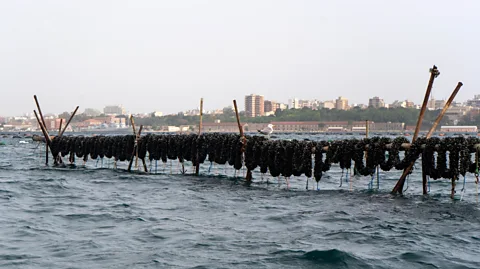 Naomi Mihara
Naomi MiharaAs filter-feeding organisms, mussels can accumulate toxic contaminants in their tissues. In 2011, concentrations of dioxins and polychlorinated biphenyls, or PCBs, that exceeded European Union standards were found in mussels grown in Mar Piccolo's first inlet, leading to a temporary ban on mussel farming in the area. Since then, stringent pollution controls have been implemented. "The local health authority takes samples to analyse. If the product is free of PCBs, dioxins, and other contaminants, they approve us to transfer the mussels from the first inlet to the second," explains Lippo.
For Lippo and other mussel farmers, the need to relocate their entire mussel crop to the second inlet is increasingly jeopardising their harvest. "From the moment all this started, mussel farming has been brought to its knees, and the mussel farmers have paid the price. The climate crisis has further accentuated these problems," says Fanelli. This past July, the temperature in the second inlet climbed to 31.5C (89F), reports Fanelli – a level that scientific research indicates can be fatal to mussels. An estimated 9,000 tonnes of mussels, valued at €8m (£6.72m, $9.07m), perished last year.
The restoration plans
Environmental remediation in Taranto has a long and complex history. "An endless story," says Vera Corbelli, the former special commissioner for Taranto's remediation efforts. Corbelli was appointed in 2014 with a mandate to lead targeted interventions to deal with the contamination. During her six-year tenure, she oversaw remediation projects and carried out extensive research covering an area of 564 sq km (218 sq miles), which includes the Mar Piccolo. "We realised that much of the Mar Piccolo had been used as a dumping ground," says Corbelli. "We found everything – cars, hospital equipment, washing machines, refrigerators. Removing this debris was our first step." Yet further progress on the ground remained frustratingly slow.
It wasn't until early 2024, when geologist Vito Felice Uricchio became the new special commissioner for Taranto's remediation efforts, that significant progress began to take shape. Although Uricchio had been working on environmental solutions for years, his efforts are only now translating into tangible policy actions.
"It started over 15 years ago," Uricchio recalls, of his environmental work in the area. "There was not only an environmental need but also a social one." At the time, Uricchio served as a researcher and coordinator. Alongside Reverend Nicola Preziuso, a priest in the Tamburi district which lies adjacent to the factory, Uricchio and his team of researchers launched a pilot project aimed at providing both ecological restoration and employment opportunities for workers who had lost their jobs. The initiative focused on decontaminating one hectare of polluted land using plants such as the Monviso clone, a species known for promoting PCB biodegradation through its root system.
"The first 600 [poplars] were planted, then another 600," Preziuso says. "We kept planting and planting. At first, the plants ranged from 50cm (20in) to 60cm (24in) in height. Over time, they've grown to about 12 to 13m (40 to 43ft), with strong, consistent trunks – a beautiful sight on a terrain condemned to be contaminated."
After a year of planting, chemical analyses revealed significant improvements, demonstrating the method's ability to address both organic and inorganic contamination. Inspired by this success, Uricchio now aims to deploy the technology on a larger scale, targeting the heavily polluted first inlet of the Mar Piccolo.
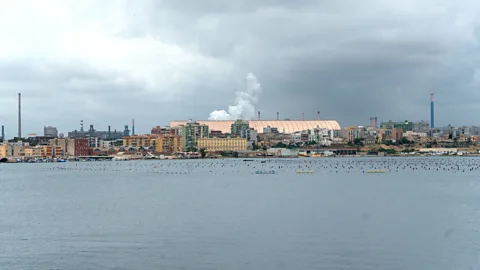 Naomi Mihara
Naomi MiharaThe process can treat soil up to 5m (16.5ft) deep – the reach of the plant roots – at a fraction of the cost of traditional remediation methods. "Traditional soil removal, or 'scarification', involves excavating contaminated soil and sending it to landfills, which is both wasteful and harmful," Uricchio explains. "It takes thousands of years to form just one centimetre of soil from bedrock. Discarding that is criminal."
Cleaning up contaminants with plants
The idea of using living organisms to clean up toxic areas is not new. Early research primarily focused on the use of microbes to break down waste materials and pollutants. Over time, scientists expanded their studies to include plants capable of performing similar functions. In the 1990s, Rutgers University biologist Ilya Raskin, who first coined the term "phytoremediation", demonstrated the technique's potential by using mustard seeds to extract heavy metals from contaminated soil around Ukraine's Chernobyl nuclear power plant.
While many plants can absorb organic compounds such as dioxins and PCBs, only certain types, known as hyperaccumulators, are capable of effectively absorbing and tolerating high concentrations of heavy metals. This group includes poplar trees, used in Uricchio's research, as well as other species like sunflowers, some types of grass, and hemp.
Though current research so far shows promise, Werther Guidi Nissim, an assistant professor at the University of Milano-Bicocca, Italy, says phytoremediation alone is unlikely to fully decontaminate an area as large as the Mar Piccolo. The long timeframes needed – from a few years for the easiest pollutants to centuries for some metal and organic compounds – are another bottleneck, according to Nissim.
Instead, the technique should be combined with other more traditional remediation methods like excavation and soil removal, he says. "Since, in most cases, sites are polluted by different contaminants, an integration between conventional and green approaches such as phytoremediation could be an interesting idea to explore."
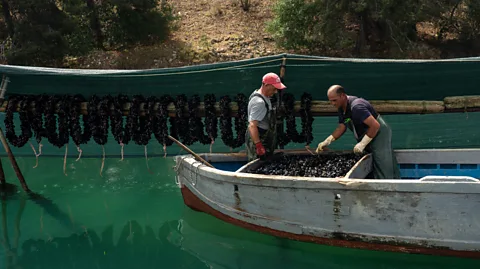 Naomi Mihara
Naomi MiharaAcknowledging these limitations, the remediation plan for Taranto encompasses both typical remediation approaches alongside more innovative approaches, says Uricchio. "Phyto-assisted bioremediation will be used in cases where contamination affects the most superficial soil layers or depths compatible with the root systems of the species intended for use," he explains.
In addition, most phytoremediation projects have so far focused on the use of terrestrial plants on land, says Nissim. In saline environments, salt-tolerant species of plants, known as halophytes, must be used, and while research is still ongoing, they also form part of Uricchio's plan for the Mar Piccolo. Algae species, such as sea lettuce, can also play a role. According to Uricchio, these algae not only help restore ecosystems but also have valuable industrial applications, including in bioethanol production.
Hope despite the barriers
Taranto is one of 42 contaminated areas in Italy designated a "site of national interest" because of the urgent need for remediation. The sixth Sentieri Report – an epidemiological study of communities living in industrially contaminated areas in Italy – highlights the severe health risks associated with living in polluted environments. It also warns that even the most well-executed remediation efforts risk being compromised by ongoing or future recontamination.
"In places like Taranto, even if we managed to carry out the best possible remediation, the benefits would be completely nullified by the continuation of polluting activities," says Agostino di Ciaula, a doctor and researcher of the effects of pollution on human health.
Despite a ruling by the European Court of Justice last year stating that the heavily indebted steel plant should be shut down if it continues to pose environmental and health risks, it remains operational. Under state ownership since 2020, the plant plans to produce 3.5 million tonnes of steel in 2025, as the Italian government searches for new owners.
Carbon Count
The emissions from travel it took to report this story were 40kg CO2. The digital emissions from this story are an estimated 1.2g to 3.6g CO2 per page view. Find out more about how we calculated this figure here.
In a joint statement, Giovanni Fiori, Davide Tabarelli and Giancarlo Quaranta, the current commissioners of Acciaierie d'Italia, tell the BBC investments in maintenance have improved efficiency and sustainability, and emissions reductions have been achieved through upgrades to cooling and gas purification systems. "These efforts are driven by the determination to lift Acciaierie d'Italia out of a period of decline, ensure production continuity, and create the conditions for a more sustainable future."
Meanwhile, Uricchio's broader vision to restore Mar Piccolo faces significant hurdles. Securing full operational permission from the Ministry of Environment and Energy Security took nearly a year, and he is still waiting for the necessary funding. Of the estimated €500m (£423m, $566m) needed for Taranto's decontamination, only €52m (£44m, $58m) is currently available. The Ministry has acknowledged the uphill battle. "The funds available in the Special Accounting [funds allocated for sites that have yet to be remediated] are partially being used to settle debts left by previous commissioners. Soon additional resources will be unlocked," a spokesperson tells the BBC.
A significant portion of funding was expected from the Contratti Istituzionali di Sviluppo (CIS) – a government-led instrument aimed at accelerating strategic projects in regions facing economic or environmental challenges, using EU and national funding. In a move criticised by trade unions and environmental groups, a decision about CIS funding for the remediation of the Mar Piccolo was effectively halted in December 2020.
Substantial funding is expected this year from the Just Transition Fund, a European Union fund aimed at supporting economic diversification and the energy transition, and the EU Fund for Development and Cohesion. Uricchio has submitted seven funding proposals on green supply chains that the Just Transition Fund could potentially support. These initiatives focus on soil and surface water decontamination and reducing particulate matter. However, Uricchio fears these funds might be insufficient, even if they are approved. "For this reason, I am advocating for the exploration of additional funding channels," he says.
With promises of action and new funding on the horizon, the question remains: will it be enough to restore Taranto's future and protect the livelihoods of mussel farmers and citizens?
The embattled Uricchio remains full of fight. "I want to act; I want to remediate as much as possible."
* The travel for this article was supported by a grant from Journalismfund Europe.
--
If you liked this story, sign up for The Essential List newsletter – a handpicked selection of features, videos and can't-miss news, delivered to your inbox twice a week.
